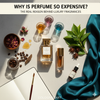
Why Is Perfume So Expensive? The Real Reason Behind Luxury Fragrances
6 min reading time

6 min reading time
Have you ever looked at a perfume price tag and wondered — why is it so expensive? From designer bottles to niche fragrances reaching hundreds of dollars, perfume pricing can feel almost mysterious. But the truth is: quality fragrance is a science, an art, and a luxury — all wrapped into one bottle.
In this blog, we break down every factor that makes perfume one of the most luxurious products in the world.
Not all perfume ingredients are created equal. Luxury fragrances use a selection of the finest raw materials available:
Natural flower absolutes: Think delicate rose or intoxicating jasmine.
Rare resins: Such as frankincense or myrrh.
Exotic fruits and spices: From distant lands, offering unique aromatic profiles.
Precious woods: Like oud, sandalwood, and cedar, known for their depth and longevity.
Animalic scents: Now mostly synthetic to protect animals, but still complex and expensive to recreate.
Some ingredients can even cost more than gold per gram! For example:
Oud oil: Can fetch up to $30,000 per kilogram.
Jasmine absolute: Requires approximately 8,000 flowers to produce just 1 milliliter.
Rose de Mai: A highly prized rose harvested only once a year in Grasse, France.
High-end perfumes prioritize these premium, often difficult-to-source materials over cheap synthetic fillers.
Behind every luxury fragrance is a master perfumer, often referred to as "The Nose." These highly specialized artisans dedicate years to honing their craft.
Creating a truly great perfume involves:
Months or even years of development: It's a meticulous, iterative process.
Hundreds of ingredient combinations: Experimentation is key to finding the perfect balance.
Multiple testing rounds: Ensuring consistency and desired effect.
Aging and refining processes: Allowing the components to meld harmoniously.
Perfumers are rare professionals with incredibly trained senses, capable of discerning the subtle nuances of thousands of ingredients. Brands pay them substantial salaries to create the signature scents we cherish, making this craftsmanship a significant part of the cost.
Many leading fragrance houses are committed to ethical and sustainable practices. This conscious approach impacts the final price tag but ensures a better product and a healthier planet.
This commitment often includes:
Fair-trade farming: Supporting communities where ingredients are grown.
Ethical harvesting: Ensuring practices that do not exploit workers or resources.
Protecting endangered plants: Sourcing alternatives or cultivating sustainably.
Supporting local communities: Investing back into the areas that provide their raw materials.
Responsible sourcing increases the cost of production, but it guarantees the quality of ingredients and contributes to long-term environmental and social sustainability.
Perfume is more than just a scent — it's an entire experience. High-end perfumes often come in exquisite packaging that reflects the luxury within.
This can include:
Crystal or custom-designed glass bottles: Often works of art in themselves.
Magnetic caps: Providing a satisfying closure and premium feel.
Gold foil designs and intricate detailing: Adding to the aesthetic appeal.
Hand-crafted boxes: Protecting the precious contents and enhancing the unboxing experience.
Limited-edition packaging: Making each bottle a collector's item.
Brands like Dior, Chanel, and Tom Ford invest heavily in bottle design. In many cases, the intricate packaging can cost more than the liquid fragrance itself.
Perfumes with greater lasting power are generally more expensive because they contain higher concentrations of pure fragrance oils. The more oil, the longer the scent lingers on your skin.
Here's a quick breakdown of common perfume concentrations:
Parfum / Extrait (20–40% oils): The most concentrated, longest-lasting, and most expensive form.
Eau de Parfum (15–20%): A strong and long-wearing option, popular for its balance.
Eau de Toilette (5–15%): Lighter and typically more affordable, perfect for everyday wear.
Body mists / Colognes (<5%): Very affordable but offer the least longevity.
If your perfume gracefully lasts 8–12 hours, you are undoubtedly paying for a quality concentration that offers superior performance.
A significant portion of a perfume's price goes into building and maintaining its brand image and market presence.
This includes:
Global advertising campaigns: Spreading awareness and desire for the product.
Celebrity and influencer endorsements: Associating the fragrance with aspirational figures.
High-end store placement: Ensuring visibility in prestigious retail environments.
Magazine ads and TV commercials: Reaching a broad audience with captivating visuals.
Packaging design teams: Creating the visually appealing branding.
Designer brands charge more because you're also investing in the name, the prestige, and the comprehensive marketing efforts that elevate the product to a luxury status.
Niche perfumes (from brands like Byredo, Maison Francis Kurkdjian, Xerjoff, or Creed) and limited editions command higher prices due to their exclusive nature and production methods.
They typically:
Avoid cheap mass production: Focusing on quality over quantity.
Use artistic and unique blends: Often pushing boundaries beyond mainstream tastes.
Offer exclusive scents: Making them harder to find and more coveted.
Maintain higher quality control: Ensuring every bottle meets rigorous standards.
This exclusivity, combined with superior ingredients and unique formulations, naturally increases the price.
Some perfumes, much like fine wine or spirits, require an aging or maturation process before they are bottled and sold.
During this period:
Ingredients blend and soften: Creating a more harmonious and rounded scent.
Harsh notes disappear: Resulting in a smoother, more refined fragrance.
The fragrance becomes richer and more complex: Developing its full character.
This additional time and specialized storage contribute to the overall cost before the product ever reaches the shelves.
The short answer: Yes — if you value quality and a unique sensory experience.
When you purchase a luxury fragrance, you're investing in:
✨ Higher-quality oils and rarer ingredients.
✨ Longer-lasting performance that evolves beautifully on the skin.
✨ Unique and complex scent compositions that stand out.
✨ Artistic craftsmanship from master perfumers.
✨ Luxurious packaging that's a pleasure to own.
While cheap perfumes might fade quickly, good perfumes tell a story, evoke memories, and truly last, making the investment worthwhile for many.
At CologneCart, we curate niche, designer, and trending perfumes at competitive prices — without compromising authenticity. Discover your next signature scent with us!